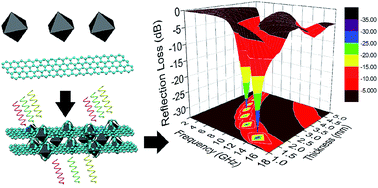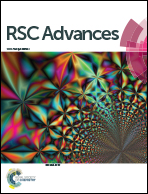Reduced graphene oxide decorated with octahedral NiS2/NiS nanocrystals: facile synthesis and tunable high frequency attenuation†
Abstract
Reduced graphene oxide (RGO) decorated with octahedral NiS2/NiS nanocrystals were fabricated via a facile synthetic strategy. By appropriate adjustment of the weight ratio of GO and NiS2/NiS nanocrystals, RGO–NiS2/NiS nanocomposites with an excellent microwave absorption performance were achieved. As expected, RGO–NiS2/NiS nanocomposites in a polyvinylidene fluoride (PVDF) matrix with different mass fractions (5, 10, 15, 20 wt%) possess effective absorption in the high frequency range with a thin thickness (1.5 mm) compared with those of octahedral NiS2/NiS nanocrystals. It was revealed that RGO–NiS2/NiS nanocomposites with a GO : NiS2/NiS weight ratio of 1 : 4 exhibited the most prominent microwave absorption property. The optimal effective frequency bandwidth of this sample covers 4.32 GHz at a thin coating layer of 1.5 mm (15 wt%). The corresponding reflection loss value can reach −32.2 dB at 14.32 GHz. Moreover, the fundamental attenuation mechanisms are also discussed in detail.



 Please wait while we load your content...
Please wait while we load your content...